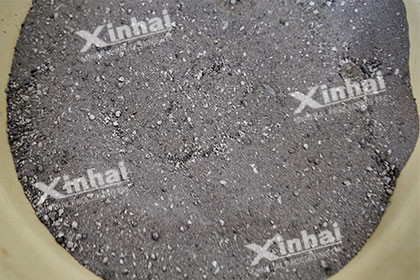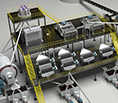What are the Common Types of Slurry Pumps?
 Shirley
Shirley
 Jul 27, 2022
Jul 27, 2022
 3698
3698
If you want to know more details about equipment, solutions, etc, please click the button below for free consultation, or leave your requirements!

(Separation drawing of slurry pump)
Slurry pumps are mainly used for the transportation of mineral slurry in beneficiation processes, which plays the role of transportation, feeding, pressurization, and discharge. On the one hand, the slurry pump can be used with mineral processing equipment, such as magnetic separator, flotation machine, screening machine, and classification machines. On the other hand, the slurry pump can directly transport the slurry to the designated position through the pipeline.
01 Slurry Pump Working Principle
BackUnder the action of centrifugal force, the liquid is thrown from the center of the impeller to the outer edge and obtains energy, leaving the outer edge of the impeller at high speed into the volute casing. In the volute pump case, the liquid is decelerated due to the gradual expansion of the flow passage, and part of the kinetic energy is converted into static pressure energy, and finally flows into the discharge pipe at relatively high pressure and is sent to a required place. When the liquid flows from the center of the impeller to the outer edge, a certain vacuum is formed at the center of the impeller. Since the pressure above the liquid level of the tank is greater than the pressure at the inlet of the pump, the liquid is continuously pressed into the impeller.

02 Common Types of Slurry Pumps
BackThere are various kinds of slurry pumps at present. Generally, slurry pumps can be classified into different types according to their working principles, structure characteristics, and applications. It's recommendable to choose the proper slurry pump type in the light of actual conditions of mineral processing plants.
(1) Slurry pumps can be divided into single-stage slurry pumps and multi-stage slurry pumps according to the number of impellers.
Single-stage Slurry Pumps
Single-stage slurry pumps, also named single-stage centrifugal pumps, are a kind of pump with only one impeller. Normally, the single-stage pump has a maximum lift of only 125 meters. It has the characteristics of simple structure, stable performance, high speed, small size, lightweight, high efficiency, large flow, easy operation, and maintenance.
Multi-stage Slurry Pump
Multi-stage slurry pumps are usually connected in series and combined with single-stage pumps. The output water pressure can be very large. A multi-stage slurry pump is a kind of centrifugal pump, which relies mainly on the rotation of the impeller to obtain centrifugal force so that the material is pumped out when the gas density reaches the working range of a mechanical vacuum pump and a high vacuum is obtained. The multi-stage slurry pump relies on the change of the volume of the pump chamber to achieve the suction, compression and exhaust and therefore belongs to the variable volume centrifugal pump.
Single-stage slurry pump VS multi-stage slurry pump:
Single-stage slurry pump refers to a pump with only one impeller, with a maximum head of 125 meters;
Multi-stage slurry pump refers to a pump with two or more impellers, the maximum head can exceed 125 meters; when a single-stage slurry pump lift requires two-stage motors, the multi-stage slurry pump can increase the number of impellers to match the four-stage motor, thus improving the service life of the slurry pump and reducing the noise of the unit. However, the maintenance difficulty of the multi-stage slurry pump is larger than that of the single-stage slurry pump.
When the actual head demand of the slurry pump is less than 125 meters, whether a single-stage pump or multi-stage pump is better should be decided according to the pump room area and pump price. Normally, the multi-stage pump is generally more expansive than the single-stage pump)

(2) Slurry pumps can be divided into horizontal slurry pumps and vertical slurry pumps according to the position of the pump shaft and water level.
Horizontal Slurry Pumps
The horizontal slurry pump is a centrifugal slurry pump, whose working principle is to transfer the mechanical energy of the prime mover into the liquid by the function of rotating the impeller on the liquid. Since the velocity and pressure energy of the liquid from the inlet to the outlet of the impeller increases, the liquid discharged from the impeller passes through the pressure chamber, and most of the velocity can be converted into pressure energy and then along the drainage pipe. At this time, due to the discharge of the liquid, a vacuum or low pressure is formed at the inlet of the impeller, and the liquid in the liquid pool is pressed into the impeller inlet under the action of the liquid surface pressure (atmospheric pressure), and the rotary impeller continuously sucks in and discharges the liquid.
Vertical Slurry Pumps
The vertical slurry pump refers to a device that increases the energy of a solid-liquid mixed medium by the action of centrifugal force caused by the rotation of the pump impeller. It is widely used in mines, power plants, sulfur, metallurgy, chemical industry, building materials, petroleum, and other industry.
Under the action of centrifugal force, the liquid is thrown from the center of the impeller to the outer edge and obtains energy, leaving the outer edge of the impeller at high speed into the volute case. In the volute pump case, the liquid is decelerated due to the gradual expansion of the flow passage, and part of the kinetic energy is converted into static pressure energy, and finally flows into the discharge pipe at relatively high pressure and is sent to a required place. When the liquid flows from the center of the impeller to the outer edge, a certain vacuum is formed at the center of the impeller. Since the pressure above the liquid level of the tank is greater than the pressure at the inlet of the pump, the liquid is continuously pressed into the impeller.
Horizontal Slurry Pumps VS Vertical Slurry Pumps
Appearance: The vertical slurry pump is in a vertical shape, while the horizontal slurry pump is in a horizontal shape;
Connection form: The vertical slurry pump is superimposed from bottom to top, and the horizontal slurry pump is arranged vertically on the base. The vertical slurry pump is generally called a pipeline pump such as a vertical pipeline centrifugal pump. The motor and the pump body are connected by a sub-port; the horizontal slurry pump is connected with a motor by a coupling and needs to be regularly corrected;
Floor space: The vertical slurry pump covers a small floor space, while the horizontal slurry pump has a large occupied area. The vertical slurry pump unit also occupies less space than the horizontal slurry pump. The infrastructure of vertical slurry pumps can be determined depending on the production needs. The horizontal slurry pump unit has a base and requires infrastructure.
Maintenance difficulty: The vertical slurry pump is difficult to overhaul. For example, it is necessary to remove the upper part of the impeller before it can be repaired; and the horizontal slurry pump is relatively easy to overhaul.
Installation form: The vertical slurry pump is connected as a whole, so the installation is easy; while the horizontal slurry pump needs to be adjusted after installation.
.jpg)
(3) Slurry pump can be divided into a single-suction slurry pump and a double-suction slurry pump according to the suction water feeding pattern.
Single-Suction Slurry Pump
The single-suction slurry pump is sucked in the horizontal axial direction and discharged radially upward. The pump is of a suspension type. The pump is connected with the motor by an ordinary elastic coupling or an extended elastic coupling. The shaft seal of the pump is sealed with a soft packing. The bearings are single-row radial ball bearings lubricated with lubricating oil. From the motor side, the pump rotates clockwise. When the single-suction slurry pump is started, the pump shaft drives the impeller to rotate at a high speed, forcing the pre-filling liquid between the blades to rotate.
Double-Suction Slurry Pump
As an important type of centrifugal pump, the double-suction slurry pump has been widely used in engineering because of its high lift and large flow. The impeller of this type of pump is actually composed of two back-to-back impellers, from which the flow of water flows into a volute.
Single-suction slurry pump VS double-suction slurry pump
Single-suction slurry pump means that only one end of the impeller enters the water, and the double-suction slurry pump is fed with water at both ends of the impeller, that is, two inlets.
The double-suction slurry pump is more suitable for large flow pumping and requires a stable operation. When the flow rate of the pump is very high, if a single-suction slurry pump is used, a large pump inlet and outlet diameter are required. At the same time, the rotation speed can’t be very high and needs to be stabilized at about 1450 rpm. If a double-suction slurry pump is used, the size and weight of the slurry pump can be relatively reduced, the rotational speed can be increased, and the volumetric efficiency can be increased.
The anti-cavitation ability of the double-suction slurry pump is stronger than that of the single-suction pump. Since the medium is sucked at both ends of the impeller, hydraulic symmetry is formed, so that the balanced axial thrust of the double suction slurry pump is better than that of the single suction slurry pump, and the operation is more stable. Moreover, the flow rate of the medium is low, and the impeller is not prone to cavitation.
The double-suction slurry pump has one more sealing chamber than the single suction slurry pump, so its cost is relatively high.

(4) Slurry pumps can be divided into single-shell slurry pumps and a double-shell slurry pump according to the structure of the pump casing.
The difference between the double-shell slurry pump and the single-shell slurry pump is mainly in the structural forms. The common point is that there are front and rearguard plates and impeller structures. The difference is that the double-shell slurry pump has a double-layer structure with a front pump cover and a rear pump cover. When transporting the slurry, the material only passes through the internal over-current components, without contact with the front and rear pumps. And only the internal over-current components need to be replaced, repaired, and maintained, so the investment cost can be greatly reduced. The single-shell slurry pump does not have a pump cover.

03To Wrap Up
BackThe above are the common types of slurry pump. With the continuous development of technology, the application fields and demand for slurry pumps will continue to expand. You can click to know how to select slurry pump and slurry pump wear reasons & commonly used wear-resistant materials.
If you want to know more about slurry pump, you can contact the online service or leave your message, we will contact you soon.
 +86 183 3575 8886
+86 183 3575 8886 pinklaurabao@gmail.com
pinklaurabao@gmail.com




 Message
Message Chat Now
Chat Now

















